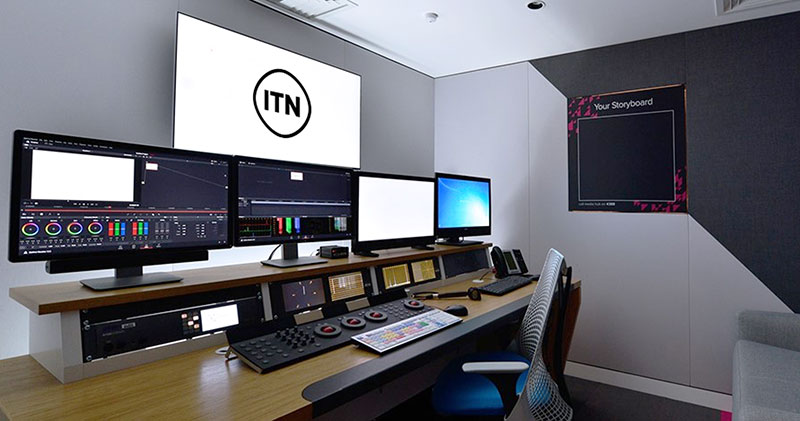ITN is transitioning on-premises workflows into the cloud via AWS, moving standard media equipment off-premises and into the data centre for speed, agility and efficiency.

Producing and delivering daily news for the major UK media outlets like Independent Television Network (ITV), Channel 4 and Channel 5 is fast-paced, competitive and requires meeting continuously changing viewer expectations. In order to stay ahead in that environment, Independent Television News (ITN) makes innovation a priority as it serves clients.
ITN broadcasts live news and events, documentaries, sports and other programming to a widely scattered audience, which requires video and data processing and transport across long distances. As demand for remote production began rising, ITN required a more straightforward approach, and began transitioning on-premises workflows into the cloud via AWS.
Cloud Opportunity
“When working with a news organisation, we want internet-based consumers to be able to access the content as quickly as possible, which isn’t always straightforward with conventional, on-premises media processing pipelines. As our equipment began showing signs of aging, we seized the opportunity to pivot and try to gain efficiency by working in the cloud,” said ITN Cloud and Software Development Manager Nick Moores. “Having now seen what’s possible, there’s no going back.”
ITN’s AWS implementation, however, fits into a larger ‘lift and shift’ strategy the company is undertaking to reduce its carbon footprint across productions and media workflows. The ITN team sees further value in moving standard media equipment off-premises and into a data centre.
“Reducing our physical footprint in London to ensure more sustainable operations is a priority. With cloud computing, we can work toward that while also going without the traditional, physical circuits that link our sites,” said Nick. “Through AWS, we can use cloud computing to create an alternative, more cost-efficient path between sites.”
New Cloud Applications
His team is also using AWS and ITN’s GVM platform, which is under development to identify new integrations for remote and decentralised production applications – for instance, cloud-based transcoding and editing. The combination of these tools and services has made it possible for ITN to produce low-latency, high-quality media using software, with greater potential for live productions.

“We can transport media across multiple destinations and bring it into AWS instances. From there we can produce shows with our traditional production capabilities like switching, audio mixing and monitoring, and then transmit the signal to viewers using VoIP,” Nick said. “The software-based techniques have saved us on kit and travel costs and made the production process more robust.”
New Services on Demand
Beyond improving ITN’s physical production footprint, the cloud is making it simpler and more affordable to set up new services on demand. “Customers are asking for rapid turnaround event support more often now, which we can deliver with AWS,” he commented.
James Wickes, the Lead Media Engineer at ITN, talked about the flexibility the AWS services have given them. “Lead times, a lack of the right equipment or test environment, or finding the right local crew are all less of a concern. We’re just beginning to realise its full flexibility, which is invaluable to us.”
Using cloud-based infrastructure, ITN has so far launched several systems designs for clients, including one that allows third-party clients to monitor a feed. It was created in a few weeks, compared to the months and extensive network capacity that creating a similar on-premises system would have needed. Making use of the AWS Marketplace, ITN’s business to-business (B2B) division also delivered a maintenance-free 24/7 video delivery service in a single day. Nick Moores notes, “The clients were excited about the results, and we were happy it didn’t impact our connectivity. There’s no way we could have replicated it on-premises.”
Historic Event
Following the passing of Queen Elizabeth II last year, British Airways approached ITN to live stream the funeral ceremony to its passengers. Using AWS Reference Architecture, they built a live video delivery system in under a week that enabled them to stream terabytes of historic live event coverage to in-flight audiences over the internet.
To execute the stream, ITN supplied on-premises connectivity to the cloud via encoding hardware, and then adopted a cloud services-based workflow. The AWS Elemental MediaLive service, which encodes live video for broadcast and streaming to connected devices, received and processed the streams. AWS Elemental MediaPackage prepared, protected and packaged the content into different distribution formats, based on configuration at the endpoint. As a just-in-time service, it automatically scaled outputs in response to audience demand.
On the Edge
The coverage was distributed via the Amazon CloudFront content delivery network (CDN), which delivers content securely with low latency and high transfer speeds. To balance cost, performance and security, users can customise the code running at the AWS content delivery network (CDN) edge using serverless compute features, and further improve security with traffic encryption and access controls.

The workflow used several other AWS services, including Amazon Simple Storage Service (Amazon S3) to create watch folders and file systems to trigger the media processing pipeline, AWS Elemental MediaConvert for on-demand video transcoding, and AWS Lambda serverless compute functions for third-party integrations.
James doesn’t believe the job would have be possible without cloud services. “I can’t even imagine trying to cram the physical equipment to execute this in our space,” he said. “Using the cloud was more cost-efficient without introducing concerns about viewer numbers, connectivity or scale. Being able to pass that video to AWS gave us huge peace of mind.”
S3 Abstraction
As an extension of its work on this project, ITN is in the process of moving on-premises folders, and file systems traditionally used to trigger media processing pipelines, to Amazon S3. Using a combination of S3 features, it will include S3 step functions to help coordinate the components of distributed applications and microservices. “The abstraction that S3 imposes as object-based storage, compared to traditional file systems used on-premises, opens many options for media processing,” notes James.
As it continues to develop its media processing workflows, ITN is also experimenting with disaster recovery (DR) and seeking a solid backup system. Realising that AWS made it possible to avoid incurring costs on an idle system, the team is currently using AWS services for DR in the Channel 4 news department in London. Should a power outage shut that studio down, the setup will allow communications, video and audio to be redirected into a virtual production environment just by clicking a button. Nearly anyone from the team could then access the broadcast from a connected site anywhere in the world and produce the show at minimal cost.
Modular AWS Template
“Compared to the investment that goes into a high-end production studio, this kind of resource management makes a huge change,” said James. “The move to a SaaS-based model in recent years also means that the studio is automatically updated instead of stopping and waiting for large upfront investments into hardware upgrades.”
ITN sees every project as an opportunity to evolve its pipeline services. “As we’ve refined our best practices, we’ve created a modular AWS template from which we can pull the necessary parts, depending on each situation, without always reinventing the wheel,” James said. “We lean into what works well for projects, while also keeping an eye open for how we can improve.”

One of the company’s priorities this year is moving their editing systems into the cloud, which ultimately means moving more of their media processing pipelines into AWS. ITN currently edits video footage on-premises but is looking to the cloud to improve content distribution. Moores explains, “The goal is to be able to share our content as broadly as possible in terms of both platform and audience.”
Keeping Up to Date
Nick, James and team are also in conversations with transmission partners to determine the best path to signal delivery, noting the increasing adoption of highly compressed low-latency formats like SRT. Improving signal delivery will allow them to bring in content more easily from off-site, control it remotely, and share it efficiently with geographically disparate team members, ultimately delivering a mixed production for transmission via traditional TV.
They’ve also begun experimenting with bonded cellular data for audio and video contribution from the field. On-site servers convert video into a baseband media format that is brought into a cellular data platform. AWS EC2 instances pick up the footage for virtual environment integration.
“This will be key as we work to get more of our newsroom content to customers outside our internal user base,” said Nick. “To this end, AWS Direct Connect is invaluable – improving application performance by connecting directly to AWS and bypassing the public internet. Once it’s all in AWS, the possibilities are very wide, and we have the scale to deliver content to whatever consumer base we need to, without any concern about viewership numbers.”
As 2023 progresses, ITN plans to develop a backbone to support more AWS-enabled applications. James said, “Up until recently, everything we’ve done has largely been an experiment, but as the ROI of AWS and the cloud become clearer, we will focus on creating a core infrastructure that ties more directly into the cloud.” aws.amazon.com






